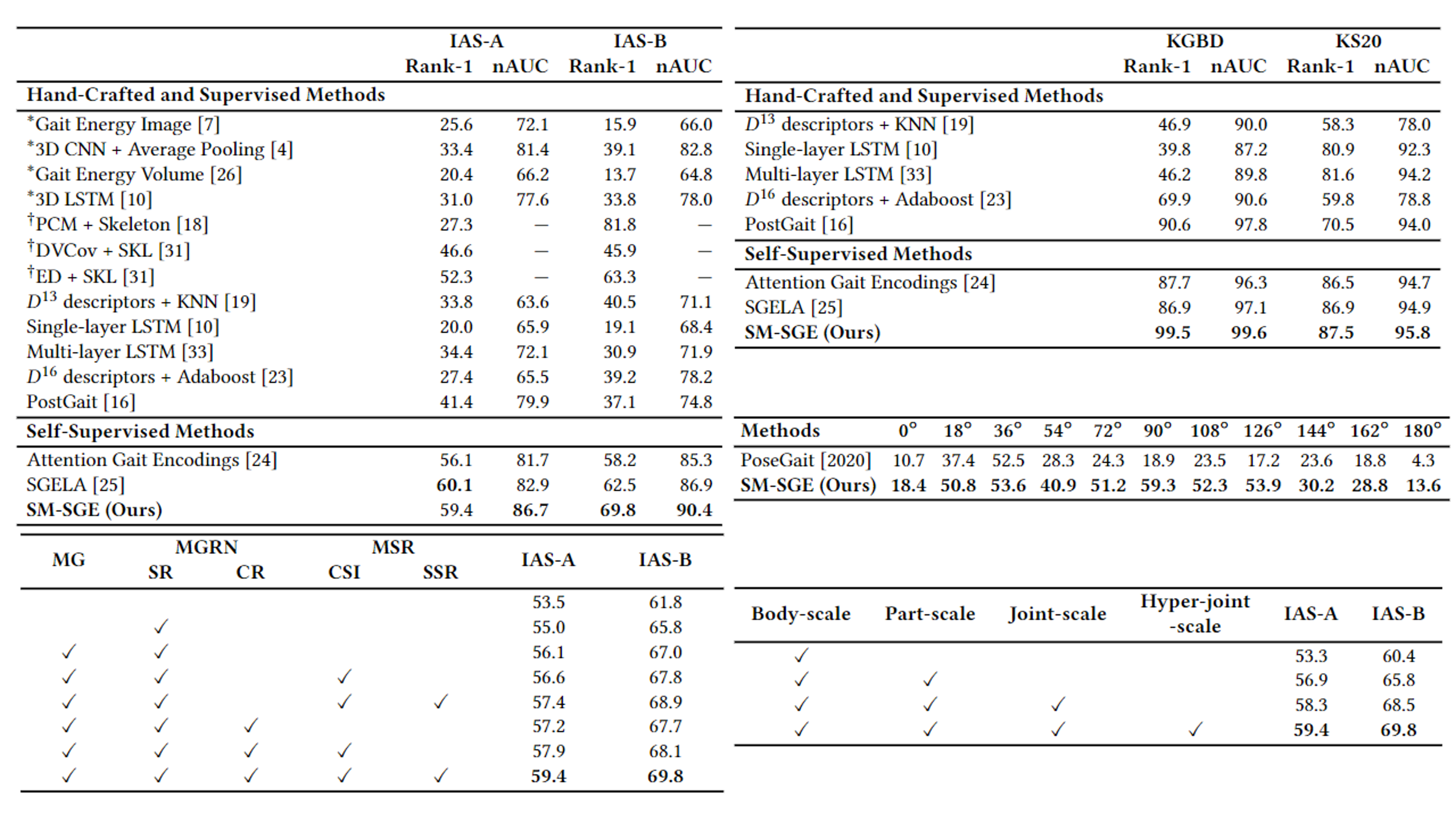SM-SGE: A Self-Supervised Multi-Scale Skeleton Graph Encoding Framework for Person Re-Identification
By Haocong Rao, Shihao Xu, Xiping Hu, Jun Cheng, Bin Hu. In ACMMM 2021.
To the best of our knowledge, this is the first skeleton-based person re-identification work accepted by ACMMM.
This is the official implementation of SM-SGE framework presented by "SM-SGE: A Self-Supervised Multi-Scale Skeleton Graph Encoding Framework for Person Re-Identification". The codes are used to reproduce experimental results in the paper (Appendix).
Abstract: Person re-identification via 3D skeletons is an emerging topic with great potential in security-critical applications. Existing methods typically learn body and motion features from the body-joint trajectory, whereas they lack a systematic way to model body structure and underlying relations of body components beyond the scale of body joints. In this paper, we for the first time propose a Self-supervised Multi-scale Skeleton Graph Encoding (SM-SGE) framework that comprehensively models human body, component relations, and skeleton dynamics from unlabeled skeleton graphs of various scales to learn an effective skeleton representation for person Re-ID. Specifically, we first devise multi-scale skeleton graphs with coarse-to-fine human body partitions, which enables us to model body structure and skeleton dynamics at multiple levels. Second, to mine inherent correlations between body components in skeletal motion, we propose a multi-scale graph relation network to learn structural relations between adjacent body-component nodes and collaborative relations among nodes of different scales, so as to capture more discriminative skeleton graph features. Last, we propose a novel multi-scale skeleton reconstruction mechanism to enable our framework to encode skeleton dynamics and high-level semantics from unlabeled skeleton graphs, which encourages learning a discriminative skeleton representation for person Re-ID. Extensive experiments show that SM-SGE outperforms most state-of-the-art skeleton-based methods. We further demonstrate its effectiveness on 3D skeleton data estimated from large-scale RGB videos.
- Python 3.5
- Tensorflow 1.10.0 (GPU)
We provide two already pre-processed datasets (IAS-Lab, KGBD) with various sequence lengths on
https://pan.baidu.com/s/1nuFH2EENyrMZbTnKGYssTw password: hyo7
Note: The access to the Vislab Multi-view KS20 dataset is available upon request. If you have signed the license agreement and been granted the right to use it, please contact me and I will share the pre-processed KS20 data.
All the best models reported in our paper can be acquired on
https://pan.baidu.com/s/1AIn7Iyfn7B-w2Eh3ZfHIZA password: sd4v
Please download the pre-processed datasets Datasets/ and model files RN/ into the current directory.
We also provide the pre-trained multi-scale skeleton graph encoding models on
https://pan.baidu.com/s/1ergZ7oJyo6fDkF2WGDNL9A password: vx48
Please download the pre-trained graph encoding models into the directory Pre-Trained/.
The original datasets can be downloaded here: IAS-Lab, KGBD, KS20.
To (1) train the SM-SGE framework to obtain skeleton representations and (2) validate their effectiveness on the downstream task of person Re-ID on a specific dataset, simply run the following command:
python SM-SGE.py --dataset KS20
# Default options: --dataset KS20 --split '' --length 6 --fusion_lambda 1 --P 8 --sample_num 1 --pre_train 1 --save_flag 1 --gpu 0
# --dataset [IAS, KGBD, KS20]
# --split ['', 'A' (for IAS-A), 'B' (for IAS-B)]
# --length [4, 6, 8, 10]
# --pre_train ['1' (train from scratch), '0' (reload pre-trained model)]
# --save_flag ['1' (save MLP models), '0' (do not save MLP models)]
# --gpu [0, 1, ...]
Please see SM-SGE.py for more details.
To print evaluation results (Re-ID Confusion Matrix / Rank-n Accuracy / Rank-1 Accuracy / nAUC) of the trained model, run:
python evaluate.py --dataset KS20 --model_dir RN/xx/xx
# Default options: --dataset KS20 --model_dir best --length 6 --gpu 0
# --dataset [IAS, KGBD, KS20]
# --model_dir [best (load the best models), RN/xx/xx (directory of model files, e.g., RN/best_models/KS20_87.5_95.8_formal)] Please see evaluate.py for more details.
To extend our SM-SGE framework to a large RGB-based gait dataset (CASIA B), we exploit pose estimation methods to extract 3D skeletons from RGB videos of CASIA B as follows:
- Step 1: Download CASIA-B Dataset
- Step 2: Extract the 2D human body joints by using OpenPose
- Step 3: Estimate the 3D human body joints by using 3DHumanPose
We provide already pre-processed skeleton data of CASIA B for Cross-View Evaluation (CVE) (f=20/30/40) on https://pan.baidu.com/s/1gDekBzf-3bBVdd0MGL0CvA password: x3e5
Please download the pre-processed datasets into the directory Datasets/.
To (1) train the SM-SGE framework to obtain skeleton representations and (2) validate their effectiveness on the downstream task of person Re-ID on CASIA B under CVE setup, simply run the following command:
python SM-SGE.py --dataset CASIA_B --length 20 --view 0
# Default options: --split '' --fusion_lambda 1 --P 8 --sample_num 1 --pre_train 1 --save_flag 1 --gpu 0
# --length [20, 30, 40]
# --view [0, 1, 2, 3, 4, 5, 6, 7, 8, 9, 10]
# --pre_train ['1' (train from scratch), '0' (reload pre-trained model)]
# --save_flag ['1' (save MLP models), '0' (do not save MLP models)]
# --gpu [0, 1, ...]
Please see SM-SGE.py for more details.
| Methods | # Params | GFLOPs |
|---|---|---|
| PoseGait | 26.80M | 364.8 |
| AGE | 7.15M | 37.4 |
| CAGE | 8.47M | 7.5 |
| SM-SGE (Ours) | 5.58M | 22.6 |
If you find this code useful for your research, please cite our paper
@inproceedings{rao2021sm,
title={SM-SGE: A Self-Supervised Multi-Scale Skeleton Graph Encoding Framework for Person Re-Identification},
author={Rao, Haocong and Hu, Xiping and Cheng, Jun and Hu, Bin},
booktitle={Proceedings of the 29th ACM International Conference on Multimedia},
pages={1812--1820},
year={2021}
}
More awesome skeleton-based models are collected in our Awesome-Skeleton-Based-Models.
Thanks to Veličković et al. for opening source of their excellent works GAT.
SM-SGE is released under the MIT License.



